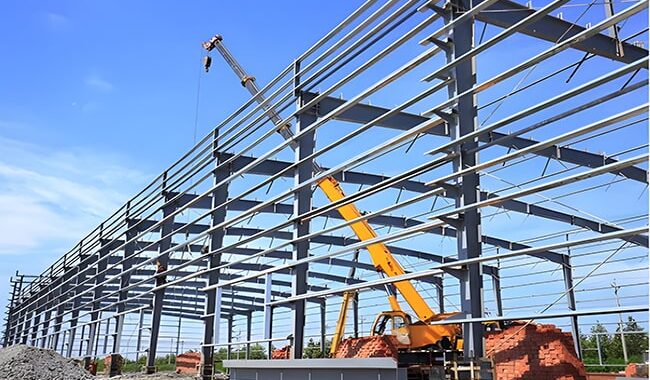In the construction of modern storage facilities, steel structure warehouses have become one of the mainstream building forms due to…
Container houses have become a new market for containers. They have the characteristics of fast transportation and have the advantage of being used alone or in combination.
Container house can be used not only as small housing, bathrooms, kitchens, laundry rooms, conference rooms, office spaces, small supermarkets, etc. but also through combined design and assembly.
It can be used in relatively large conference rooms, villa-style residences, hospitals, hotels, office buildings, etc.; it can also be widely used in temporary activity venues, such as oil fields, mines, battlefields, areas with damaged houses after disasters, etc. Generally speaking, the use of housing containers is highly temporary.

Introduction to Container Houses:
Container houses are steel structure houses similar to container forms, also known as box buildings.
The main structure and internal and external decoration of container houses, including internal water and electricity installation, functional area division, and room supporting facilities (such as color TVs, refrigerators, washing machines, bathing devices, sanitation, and furniture, etc.), are all completed in the factory and are completed at the construction site.
The project includes the installation of the house on the prefabricated base and the connection to water and electricity. Some improvement processes include the installation and electrical connection of the power distribution cabinet in the house, the connection between the water inlet of the house and the outdoor water source pipe network, and the connection between the house sewage outlet and the outdoor sewage pipe network.
The container house has the characteristics of industrial production, reflecting the characteristics of fast, changeable, simple, and efficient construction; it adopts a non-masonry structure, the overall mass is light, and the steel structure is connected through nodes, and the flexibility and mobility of the structure make it It has strong anti-seismic performance; it has an integral bottom structure, which facilitates the installation of dampers. Under the action of dampers, its anti-seismic effect is more pronounced.
The Characteristics:
Advantage:
- Generally, steel structure is the main structure, and wooden structure is the supplement;
- The structure is connected by welding or bolting, and its reliability can be guaranteed through process inspection or post-completion testing;
- The box has an insulation layer, and the insulation effect is noticeable. The house built with it has better insulation performance than the traditional masonry structure house;
- Doors and windows of houses built with it have strong reliability, safety, and flexibility and are more individual;
- Its interior decoration and decoration adopt industrial standards to improve safety and reliability;
- The design and installation of water and electricity must meet the installation regulations and standards of the area of use;
- It has a specific ability to resist wind, earthquake, and snow disasters, which can be verified through impact tests;
- Fire protection design is more reasonable;
- The area utilization rate is high, and the wall thickness of the house built by it is smaller than the wall thickness of the masonry structure house (generally 240mm);
- The total mass of the house built by it is lower than that of ordinary buildings, and the pressure on the foundation is smaller.
Shortcoming:
- Insufficient fire protection performance. When the combustion temperature reaches 600°C, the steel structure will melt;
- Steel structures are prone to rust, so anti-rust measures must be taken.
The Classification:
1. Flat-packed container house
Flat-packed container houses are generally based on 20-foot standard containers. The top and bottom of this type of house are equipped with corner pieces that meet ISO 20-foot standard container transportation requirements. The corner pieces have components connected to the corner posts, forming an integral structure with the top and bottom. The assembly is simple and quick;
The production company completes the production of the overall structure of the workshop’s top and bottom corner posts, windows, doors, and insulation panels. Then, it uses the bottom of the box as the load-bearing mechanism and the top as the cover to assemble it into a 20-foot standard container.
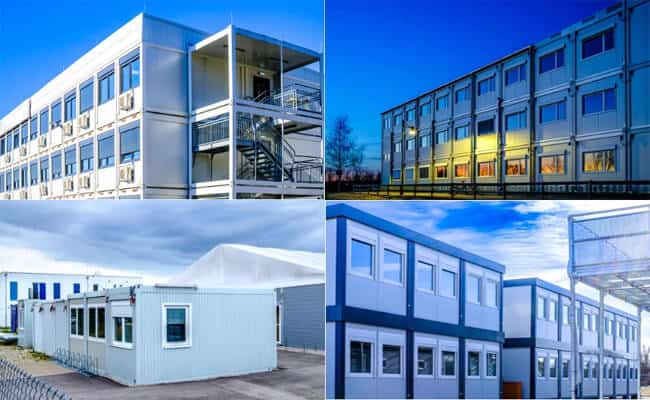
Since the Flat-packed house adopts splicing installation, the waterway system must be designed and added on-site. If the house is assembled from multiple Flat-packed container houses, the waterproofing of the joints of the splicing boxes must be considered, and a unique drainage mechanism needs to be designed.
The circuits of this type of house are generally arranged on the top and sides, and circuits and waterways are usually not placed on the walls except for switches and sockets. Due to the plug-in connection frame structure, flat-packed container houses are weaker than dry box house containers and are suitable for places with less rain and natural disasters.
2. Shipping Container Houses
This type of house is modified using standard second-hand shipping containers. The steel structure is modified based on ISO standard shipping containers, and internal and external insulation layers, decorative panels, etc., are added to complete the main structure; keels are set between the internal and external insulation layers to increase the strength of interior walls.
The floor is made of foam or fiber cement board; the surface laying materials can be plastic floor, wooden floor, bamboo floor or pasted floor tiles, etc.; the interior wall is generally made of gypsum board or fiber cement board, and then wallpaper is laid.
Insulation materials can be rock wool, fiberglass, or polyurethane foam materials according to the use environment;
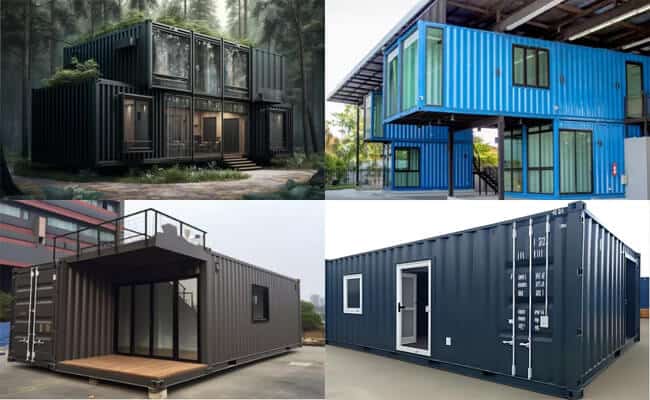
Internal facilities are equipped following customer requirements;
The shipping corner pieces are arranged in standard positions of ISO standard containers to facilitate the transportation of house containers. Shipping container houses have high structural strength and are easy to transport, making them favored by many customers;
However, since the shell used to build the house is entirely made of steel, it lacks a sense of warmth and is more suitable for use as an office space.
Corner pieces are arranged on the top of the container for easy transportation. Shipping container houses have high structural strength and are easy to transport, making them favored by many customers.
However, since the shell used to build the house is entirely made of steel, it lacks a sense of warmth and is more suitable for use as an office space.
Water and electricity:
The water circuit of the house is generally arranged between the outer insulation layer and the inner keel. The top circuit is placed in the insulation layer, and the water channel is usually slotted on the bottom cement board. The drainage channel is set under the cement board to reduce damage to the cement board, and appropriate safety protection measures are taken for the pipelines extending outside the box.
Appearance decoration:
A ceiling and outer draping are added to increase the appearance’s beauty and improve the thermal insulation performance. The ceiling can be made of galvanized steel plates, aluminized steel plates, PVC profiles, fiber cement boards, etc., with a thermal insulation coating added on the outer surface to enhance the thermal insulation effect and a slope layout to reduce the risk of water leakage; the outer hanging material can be plated Zinc steel plates, aluminized steel plates, aluminum profiles, PVC profiles, fiber cement boards, etc. have outer steel plates and are very convenient for hanging.
3. Light steel keel-type container house
Light steel keel-type container houses are divided into the following two forms:
(1) The manufacturer assembles the structure in the factory, installs it on the base of the site, and then connects water and electricity before use;
(2) The structural modules of the house are loaded into containers and transported to the use site by the manufacturer after the factory production is completed. Then, the individual panels are assembled and ready for use.
The light steel keel-type container house has a stable bottom structure system. The walls and roof are mainly made of steel keels. There are decorative panels inside and external wall drapes outside the walls. The keel mechanism between the decorative panels and drapes supports the wall. Surface, the top adopts a light steel system and external roof structure.
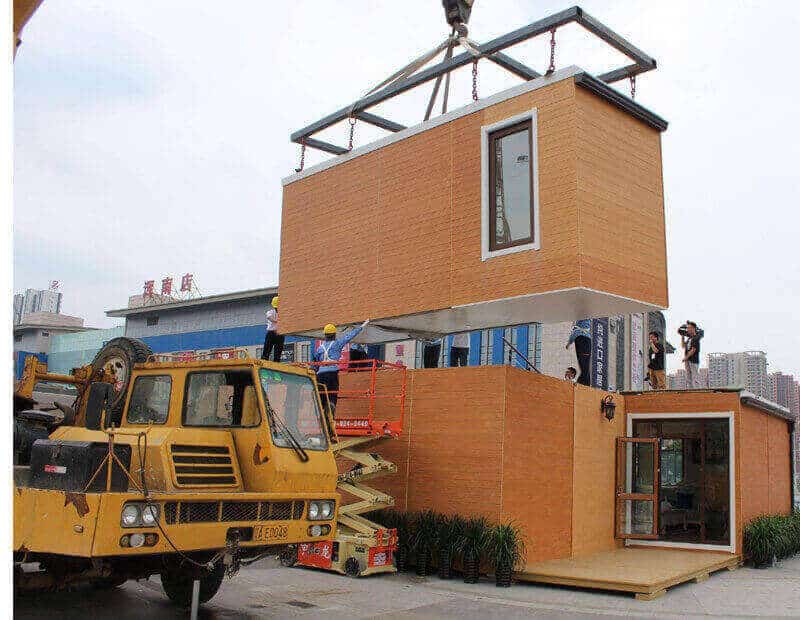
Compared with shipping container houses, light steel keel-type house containers have the following advantages:
- More warm atmosphere;
- Fewer materials are used, and the difficulty of production is reduced;
- Eliminate the exterior wall panels and exterior roof panels and directly use exterior roof draping panels and exterior wall draping panels to prevent rainwater accumulation and leakage effectively;
- Lighter in weight and more in line with low-carbon and environmentally friendly requirements;
- Since a light steel keel supports its top, it has more structural plasticity and flexibility, and its internal segmentation is more straightforward and accessible. The electrical and waterway layout principle of light steel keel-type house containers is the same as that of dry box-type house containers; that is, the safety regulations of the area of use must be followed to ensure its safety.
4. Expandable container house
The expandable container house is a combination of two boxes. One side of the main box is closed, and the other is open. The auxiliary box is equivalent to a drawer. The difficulty in designing this type of container house lies in the convenience and fit of the pull-out, the rationality of the auxiliary box support, and the sealing and waterproofing after pull-out and closing.
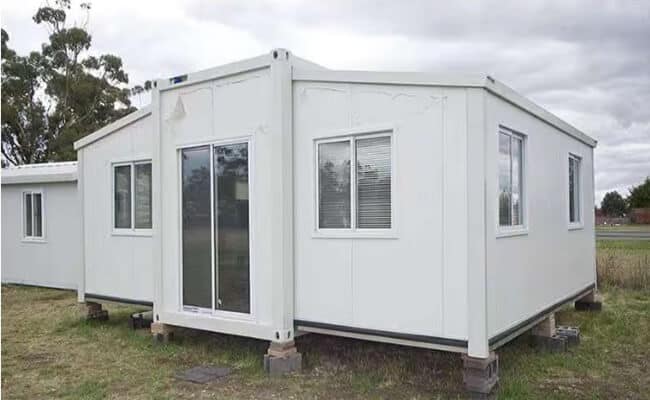
The circuit layout of this type of house container adopts the on-site plug-in method, and the waterway layout adopts a combination of pre-installation and on-site installation. Expandable container houses give full play to the flexibility of containers. One 40-foot house container can be expanded into two 40-foot container-sized houses.
5. Wooden structure container house
It adopts a wooden structure system and some steel structures, generally connected by nodes, and its interior and exterior are decorated with rapid assembly materials. When using a wooden structure container house, you need to build a foundation in advance. The container is modularly transported to the installation site, and the house is built through connections. The water circuits of such container houses generally adopt the method of “external procurement + on-site installation.” Houses built with wooden structure container houses have the advantages of being green and environmentally friendly and meet specific strength and stability requirements. This house container type is widely used in Europe, America, and Japan.
Summarize:
Container houses must use modern technology for intelligent design, modular production, and simplified assembly. At the same time, new technologies such as solar, light, wind, and air energy must be combined with housing containers to form a unique industrial chain to expand the container house market. The industry is new, green, and environmentally friendly, and its future development prospects are up and coming.














